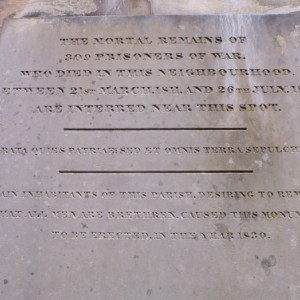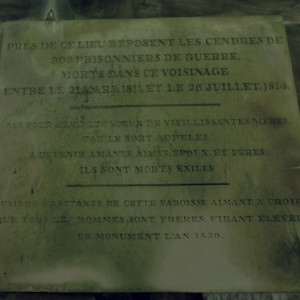Valleyfield Sepulchral Monument
Category B listed the monument (also known as the French Prisoners' Monument) was raised by Alexander Cowan, owner of the Valleyfield Paper Mills, in 1830. Tucked away at the edge of a modern housing estate, the monument (which could benefit from a little TLC to remove ingrowing vegetation) represents a period of local history of great signiificance.
Not finding a sufficiently detailed link I have copied from the information board:
Valleyfield, from its opening in March 1811 until its closure as a prisoner-of-war depot in September 1814 after the first abdication of Napoleon Bonaparte, held in aggregate some 7,500 prisoners - more than any such depot in Scotland except Perth which held 7,700.
Penicuik indeed was unique in Britain in having no less than three separate prisoner-of-war depots during the Napoleonic Wars. the two others were Greenlaw (now the site of Glencorse Barracks) from 1803 until 1814, and Esk Mills, half a mile from here down the river North Esk, for six weeks in 1811. Around 9,500 prisoners therefore passed their captivity - lasting in some cases as long as 10 or 11 years - at Penicuik.
Most (about two-thirds) of these prisoners-of-war were French; the remainder were drawn from virtually every nationality in Europe. There were hundreds of Germans, Italians, Danes and Norwegians and varying numbers of Dutch, Belgians, Luxemburgers, (sic) Spanish, Portuguese, Swiss, Poles, Russians, Austrians, Greek, Hungarians, Croats, Serbs, Swedes, Icelanders, Finns, Lithuanians, Latvians and Estonians. There were also a few prisoners from the United States, Canada, Latin America, the West Indies, Africa and the Middle East.
These men and boys (a few were over 60 years of age; scores were aged between 9 and 16) were swept by the world-wide character of the Napoleonic Wars into captivity at Penicuik. A few prisoners were accompanied by their wives, captured with them on the battlefields or at sea.
Most of the prisoners were from Napoleon's armies and navies - including some soldiers from his Imperial Guard, and some seamen captured at Trafalgar. Others were merchant seamen, corsairs, civilian passengers, and even a few fishermen. All shared their years of captivity at Penicuik.
After the calamities of war, the inscription, chosen for this monument erected in 1830 by Alexander Cowan, owner of the Valleyfield Paper Mills in which the prisoners were held captive, is apt: ALL MEN ARE BRETHREN.
The first extra is a closeup of the inscription, which reads:
THE MORTAL REMAINS OF 309 PRISONERS OF WAR WHO DIED IN THIS NEIGHBOURHOOD BETWEEN 21ST MARCH AND 26TH JULY 1814 ARE INTERRED NEAR THIS SPOT.
GRATA QUIES PATRIAE: SED ET OMNIS TERRA SEPULCHRUM
CERTAIN INHABITANTS OF THIS PARISH, DESIRING TO REMEMBER THAT ALL MEN ARE BRETHREN, CAUSED THIS MONUMENT TO BE ERECTED, IN THE YEAR 1830.
The second extra is of the reverse, which bears the same message in French.


Comments
Sign in or get an account to comment.


